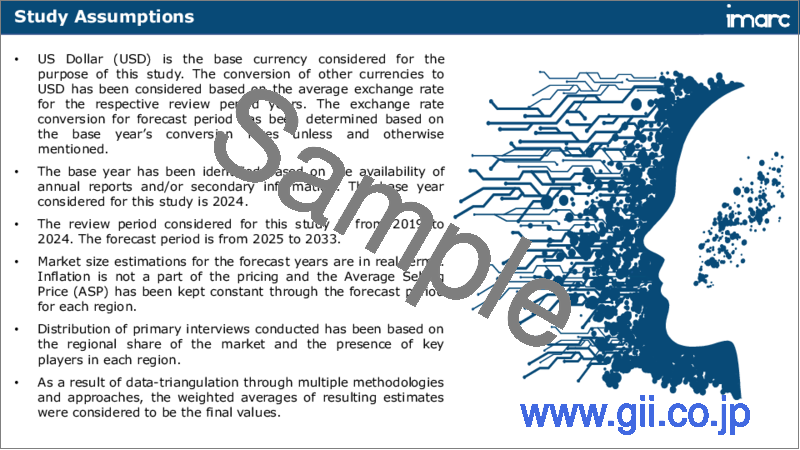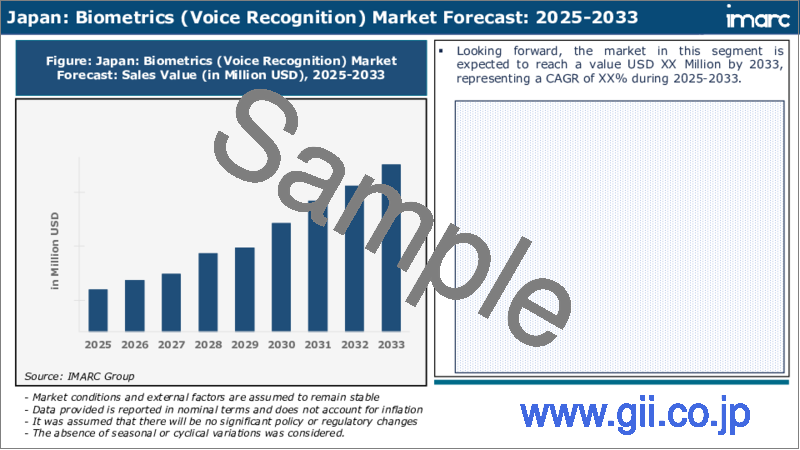|
|
市場調査レポート
商品コード
1746522
日本の生体認証市場レポート:技術別、機能別、コンポーネント別、認証別、エンドユーザー別、地域別、2025~2033年Japan Biometrics Market Report by Technology, Functionality, Component, Authentication, End User, and Region 2025-2033 |
||||||
カスタマイズ可能
|
|||||||
| 日本の生体認証市場レポート:技術別、機能別、コンポーネント別、認証別、エンドユーザー別、地域別、2025~2033年 |
|
出版日: 2025年06月02日
発行: IMARC
ページ情報: 英文 122 Pages
納期: 5~7営業日
|
- 全表示
- 概要
- 目次
日本の生体認証市場規模は、2025~2033年の間に12.4%の成長率(CAGR)を示すと予測されています。官民両部門におけるセキュリティと本人確認に関する懸念の高まり、空港セキュリティと出入国管理における交通分野での採用の増加、高度なハードウェアとソフトウェアの手頃な価格と入手しやすさの向上が、市場を牽引する主な要因です。
本レポートで扱う主な質問
- 日本の生体認証市場はこれまでどのように推移し、今後どのように推移するのか?
- COVID-19が日本の生体認証市場に与えた影響は?
- 日本の生体認証市場の技術別区分は?
- 日本の生体認証市場の機能別区分は?
- 日本の生体認証市場のコンポーネント別区分は?
- 日本の生体認証市場の認証別区分は?
- 日本の生体認証市場のエンドユーザー別区分は?
- 日本の生体認証市場のバリューチェーンにおける様々なステージとは?
- 日本の生体認証市場の主要な促進要因と課題は何か?
- 日本の生体認証市場の構造と主要プレーヤーは?
- 日本の生体認証市場における競合の程度は?
目次
第1章 序文
第2章 調査範囲と調査手法
- 調査の目的
- ステークホルダー
- データソース
- 市場推定
- 調査手法
第3章 エグゼクティブサマリー
第4章 日本の生体認証市場-イントロダクション
- 概要
- 市場力学
- 業界動向
- 競合情報
第5章 日本の生体認証市場情勢
- 過去および現在の市場動向(2019~2024年)
- 市場予測(2025~2033年)
第6章 日本の生体認証市場- 技術別
- 顔認識
- 手形認識
- 音声認識
- 署名認識
- 虹彩認識
- AFIS
- 非AFIS
- その他
第7章 日本の生体認証市場- 機能別
- 接触
- 非接触
- 組み合わせ
第8章 日本の生体認証市場- コンポーネント別
- ハードウェア
- ソフトウェア
第9章 日本の生体認証市場- 認証別
- 単一要素認証
- 多要素認証
第10章 日本の生体認証市場- エンドユーザー別
- 政府
- 防衛サービス
- 銀行・金融
- 家電
- ヘルスケア
- 商業安全・セキュリティ
- 輸送/ビザ/物流
- その他
第11章 日本の生体認証市場-競合情勢
- 概要
- 市場構造
- 市場企業のポジショニング
- 主要成功戦略
- 競合ダッシュボード
- 企業評価象限
第12章 主要企業のプロファイル
第13章 日本の生体認証市場- 業界分析
- 促進要因・抑制要因・機会
- ポーターのファイブフォース分析
- バリューチェーン分析
第14章 付録
Japan biometrics market size is projected to exhibit a growth rate (CAGR) of 12.4% during 2025-2033. The growing concerns about security and identity verification in both public and private sectors, rising adoption in transportation sector for airport security and immigration, and increasing affordability and accessibility of sophisticated hardware and software represent some of the key factors driving the market.
Biometrics facilitates analyzing and measuring of biological characteristics for identifying individuals. It relies on fingerprint recognition for access control and identification. It also includes iris and retina scans, which scan the unique patterns in the eye. It consists of facial recognition that analyzes facial features and is used in a range of applications. It also encompasses voice recognition and deoxyribonucleic acid (DNA) profiling, which is a powerful tool in criminal investigation and paternity testing due to its high level of accuracy. It relies on the premise that certain features are distinctive to each person, making them ideal for authentication and verification purposes. Biometrics offer a high level of security, as they are difficult to replicate, making them a critical tool in fraud prevention. It is often more convenient than traditional methods like passwords or personal identification numbers (PINs), as they do not require users to remember complex codes. It can significantly reduce identity theft and fraud since the unique traits of an individual are difficult to fake. Biometrics can enable highly personalized experiences, ranging from customizing settings on a smartphone to providing tailored healthcare.
Japan Biometrics Market Trends:
At present, increasing concerns about security and identity verification in both public and private sectors represents one of the crucial factors impelling the growth of the market in Japan. Besides this, the escalating demand for fingerprint recognition facilities in smartphones, tablets, and laptops are contributing to the market growth in the country. In addition, the growing adoption of biometric-based identity programs for citizen services, border control, and law enforcement is offering a favorable market outlook in the country. Apart from this, the increasing utilization of biometrics in the healthcare sector for patient identification and access control, streamlining processes, and reducing errors are supporting the growth of the market. The adoption of biometrics in the transportation sector for airport security and immigration, simplifying passenger verification, and improving overall efficiency are strengthening the market growth in the country. Machine learning (ML) and artificial intelligence (AI) are facilitating the development of more accurate and adaptable biometric systems capable of recognizing individuals in diverse conditions and across various modalities. Moreover, the integration of biometrics with other emerging technologies like internet of things (IoT) and blockchain is creating new frontiers for secure authentication and identity management. Furthermore, the increasing affordability and accessibility of biometric hardware and software are also bolstering the market growth in the country.
Japan Biometrics Market Segmentation:
Technology Insights:
- Face Recognition
- Hand Geometry
- Voice Recognition
- Signature Recognition
- Iris Recognition
- AFIS
- Non-AFIS
- Others
Functionality Insights:
- Contact
- Non-contact
- Combined
Component Insights:
- Hardware
- Software
Authentication Insights:
- Single-Factor Authentication
- Multifactor Authentication
End User Insights:
- Government
- Defense Services
- Banking and Finance
- Consumer Electronics
- Healthcare
- Commercial Safety and Security
- Transport/Visa/Logistics
- Others
Competitive Landscape:
The market research report has also provided a comprehensive analysis of the competitive landscape. Competitive analysis such as market structure, key player positioning, top winning strategies, competitive dashboard, and company evaluation quadrant has been covered in the report. Also, detailed profiles of all major companies have been provided. Some of the key players include:
- Fujitsu Limited
- Japan Computer Vision Corp.
- Mofiria Corporation
- NEC Corporation
- Suprema Inc.
- Towa Corporation
Key Questions Answered in This Report:
- How has the Japan biometrics market performed so far and how will it perform in the coming years?
- What has been the impact of COVID-19 on the Japan biometrics market?
- What is the breakup of the Japan biometrics market on the basis of technology?
- What is the breakup of the Japan biometrics market on the basis of functionality?
- What is the breakup of the Japan biometrics market on the basis of component?
- What is the breakup of the Japan biometrics market on the basis of authentication?
- What is the breakup of the Japan biometrics market on the basis of end user?
- What are the various stages in the value chain of the Japan biometrics market?
- What are the key driving factors and challenges in the Japan biometrics?
- What is the structure of the Japan biometrics market and who are the key players?
- What is the degree of competition in the Japan biometrics market?
Table of Contents
1 Preface
2 Scope and Methodology
- 2.1 Objectives of the Study
- 2.2 Stakeholders
- 2.3 Data Sources
- 2.3.1 Primary Sources
- 2.3.2 Secondary Sources
- 2.4 Market Estimation
- 2.4.1 Bottom-Up Approach
- 2.4.2 Top-Down Approach
- 2.5 Forecasting Methodology
3 Executive Summary
4 Japan Biometrics Market - Introduction
- 4.1 Overview
- 4.2 Market Dynamics
- 4.3 Industry Trends
- 4.4 Competitive Intelligence
5 Japan Biometrics Market Landscape
- 5.1 Historical and Current Market Trends (2019-2024)
- 5.2 Market Forecast (2025-2033)
6 Japan Biometrics Market - Breakup by Technology
- 6.1 Face Recognition
- 6.1.1 Overview
- 6.1.2 Historical and Current Market Trends (2019-2024)
- 6.1.3 Market Forecast (2025-2033)
- 6.2 Hand Geometry
- 6.2.1 Overview
- 6.2.2 Historical and Current Market Trends (2019-2024)
- 6.2.3 Market Forecast (2025-2033)
- 6.3 Voice Recognition
- 6.3.1 Overview
- 6.3.2 Historical and Current Market Trends (2019-2024)
- 6.3.3 Market Forecast (2025-2033)
- 6.4 Signature Recognition
- 6.4.1 Overview
- 6.4.2 Historical and Current Market Trends (2019-2024)
- 6.4.3 Market Forecast (2025-2033)
- 6.5 Iris Recognition
- 6.5.1 Overview
- 6.5.2 Historical and Current Market Trends (2019-2024)
- 6.5.3 Market Forecast (2025-2033)
- 6.6 AFIS
- 6.6.1 Overview
- 6.6.2 Historical and Current Market Trends (2019-2024)
- 6.6.3 Market Forecast (2025-2033)
- 6.7 Non-AFIS
- 6.7.1 Overview
- 6.7.2 Historical and Current Market Trends (2019-2024)
- 6.7.3 Market Forecast (2025-2033)
- 6.8 Others
- 6.8.1 Historical and Current Market Trends (2019-2024)
- 6.8.2 Market Forecast (2025-2033)
7 Japan Biometrics Market - Breakup by Functionality
- 7.1 Contact
- 7.1.1 Overview
- 7.1.2 Historical and Current Market Trends (2019-2024)
- 7.1.3 Market Forecast (2025-2033)
- 7.2 Non-contact
- 7.2.1 Overview
- 7.2.2 Historical and Current Market Trends (2019-2024)
- 7.2.3 Market Forecast (2025-2033)
- 7.3 Combined
- 7.3.1 Overview
- 7.3.2 Historical and Current Market Trends (2019-2024)
- 7.3.3 Market Forecast (2025-2033)
8 Japan Biometrics Market - Breakup by Component
- 8.1 Hardware
- 8.1.1 Overview
- 8.1.2 Historical and Current Market Trends (2019-2024)
- 8.1.3 Market Forecast (2025-2033)
- 8.2 Software
- 8.2.1 Overview
- 8.2.2 Historical and Current Market Trends (2019-2024)
- 8.2.3 Market Forecast (2025-2033)
9 Japan Biometrics Market - Breakup by Authentication
- 9.1 Single-Factor Authentication
- 9.1.1 Overview
- 9.1.2 Historical and Current Market Trends (2019-2024)
- 9.1.3 Market Forecast (2025-2033)
- 9.2 Multifactor Authentication
- 9.2.1 Overview
- 9.2.2 Historical and Current Market Trends (2019-2024)
- 9.2.3 Market Forecast (2025-2033)
10 Japan Biometrics Market - Breakup by End User
- 10.1 Government
- 10.1.1 Overview
- 10.1.2 Historical and Current Market Trends (2019-2024)
- 10.1.3 Market Forecast (2025-2033)
- 10.2 Defense Services
- 10.2.1 Overview
- 10.2.2 Historical and Current Market Trends (2019-2024)
- 10.2.3 Market Forecast (2025-2033)
- 10.3 Banking and Finance
- 10.3.1 Overview
- 10.3.2 Historical and Current Market Trends (2019-2024)
- 10.3.3 Market Forecast (2025-2033)
- 10.4 Consumer Electronics
- 10.4.1 Overview
- 10.4.2 Historical and Current Market Trends (2019-2024)
- 10.4.3 Market Forecast (2025-2033)
- 10.5 Healthcare
- 10.5.1 Overview
- 10.5.2 Historical and Current Market Trends (2019-2024)
- 10.5.3 Market Forecast (2025-2033)
- 10.6 Commercial Safety and Security
- 10.6.1 Overview
- 10.6.2 Historical and Current Market Trends (2019-2024)
- 10.6.3 Market Forecast (2025-2033)
- 10.7 Transport/Visa/Logistics
- 10.7.1 Overview
- 10.7.2 Historical and Current Market Trends (2019-2024)
- 10.7.3 Market Forecast (2025-2033)
- 10.8 Others
- 10.8.1 Historical and Current Market Trends (2019-2024)
- 10.8.2 Market Forecast (2025-2033)
11 Japan Biometrics Market - Competitive Landscape
- 11.1 Overview
- 11.2 Market Structure
- 11.3 Market Player Positioning
- 11.4 Top Winning Strategies
- 11.5 Competitive Dashboard
- 11.6 Company Evaluation Quadrant
12 Profiles of Key Players
- 12.1 Fujitsu Limited
- 12.1.1 Business Overview
- 12.1.2 Services Offered
- 12.1.3 Business Strategies
- 12.1.4 SWOT Analysis
- 12.1.5 Major News and Events
- 12.2 Japan Computer Vision Corp.
- 12.2.1 Business Overview
- 12.2.2 Services Offered
- 12.2.3 Business Strategies
- 12.2.4 SWOT Analysis
- 12.2.5 Major News and Events
- 12.3 Mofiria Corporation
- 12.3.1 Business Overview
- 12.3.2 Services Offered
- 12.3.3 Business Strategies
- 12.3.4 SWOT Analysis
- 12.3.5 Major News and Events
- 12.4 NEC Corporation
- 12.4.1 Business Overview
- 12.4.2 Services Offered
- 12.4.3 Business Strategies
- 12.4.4 SWOT Analysis
- 12.4.5 Major News and Events
- 12.5 Suprema Inc.
- 12.5.1 Business Overview
- 12.5.2 Services Offered
- 12.5.3 Business Strategies
- 12.5.4 SWOT Analysis
- 12.5.5 Major News and Events
- 12.6 Towa Corporation
- 12.6.1 Business Overview
- 12.6.2 Services Offered
- 12.6.3 Business Strategies
- 12.6.4 SWOT Analysis
- 12.6.5 Major News and Events
13 Japan Biometrics Market - Industry Analysis
- 13.1 Drivers, Restraints, and Opportunities
- 13.1.1 Overview
- 13.1.2 Drivers
- 13.1.3 Restraints
- 13.1.4 Opportunities
- 13.2 Porters Five Forces Analysis
- 13.2.1 Overview
- 13.2.2 Bargaining Power of Buyers
- 13.2.3 Bargaining Power of Suppliers
- 13.2.4 Degree of Competition
- 13.2.5 Threat of New Entrants
- 13.2.6 Threat of Substitutes
- 13.3 Value Chain Analysis






